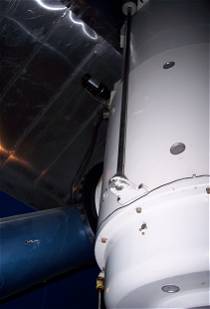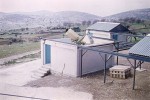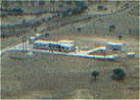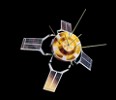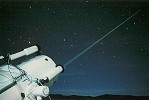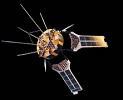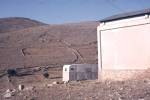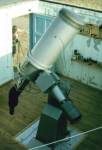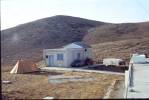|
The sky's scenery
and the mysteries of the universe have enchanted mankind since ancient
times. At Stephani our ancestors used to explain the reason for
day and night, the ongoing seasons, the origin of the stars and
other wondrous phenomena of our night sky, with myths, legends and
folktales. But for the last four decades now, we have been turning
to scientists to lead us through the dark infinity of the firmament.
Their theories and discoveries have opened our imagination to space
through the village's gate to man's final frontier: The Stephanion
Observatory situated on Dragatoura Hill (trans. Field guard's outlook).
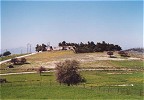 |
|
The
Stephanion Observatory on Dragatoura Hill
|
The Foundation
of the Stephanion Observatory
In spite of Greece's blue skies, a fact that contributed considerably
to the development of the science of the Heavens by the ancient
Greek philosophers, no observatory properly equipped for modern
astrophysical observations was in operation in the country until
the beginning of the 1960s. Although preparatory work for the selection
of sites which could be suitable for the installation of an astrophysical
observatory had been realised by the Greek National Committee for
Astronomy, further progress was stalled due to the lack of necessary
funding.
At that time foreign
astronomers had an interest in Greece as well. In the beginning
of 1964 a group of Dutch astronomers visited Greece in order to
examine the possibility of installing in Greece a small reflector
belonging to the Utrecht Observatory, which would then be used by
astronomers of all astronomical institutions of the Netherlands.
The group consisting of Adrian Blaauw and Jan Borgman of the Sterrenkundig
Laboratorium Kapteyn in Groningen, S.J. de Kort, of the Astronomical
Laboratory, Catholic University of Nijmegen and Anne B. Underhill,
of the Astronomical Observatory "Sonnenborgh" in Utrecht,
attended a meeting of the Greek National Committee for Astronomy
in Athens during which the existing climatological data for various
sites in Greece was examined. On the basis of these discussions
it was decided to investigate more closely the regions of Argolis
and Corinthia situated on the Peloponnese in Southern Greece. In
the spring of 1964 the Dutch Group accompanied by Greek professor
Lyssimachos N. Mavridis of the Aristotle University of Thessaloniki,
visited for the first time the area of the village of Stephani.
After also visiting several other locations in Argolis and Corinthia
the Dutch astronomers returned to the Netherlands for further consultations
with the relevant Dutch authorities.
It wasn't until February
1966 that the plans for the new Observatory took shape, when the
NATO Science Committee granted to professor Lyssimachos N. Mavridis
and German professor Heinz Neckel of the Hamburg Observatory a research
grant of 14.000 US$, for the installation of a 38 cm reflector belonging
to the Hamburg Observatory and the execution of photoelectric observations
in Greece. Based on the experience gained by the visits of 1964,
Mavridis and Neckel decided to install the telescope on a hilltop
nearby the village of Stephani at an altitude of 800 m. Thus the
Stephanion Observatory was born and Hellenic Astronomy entered a
new age.
The photoelectric observations with the German 38cm reflector, which
was equipped with a photoelectric photometer for carrying out observations
in the U,B,V colours of the international U,B,V system, started
in March 1967 and continued until September 1970, when the NATO
project was terminated and the telescope was transported back to
Hamburg. The German team under H. Neckel carried out photoelectric
observations of M-Type stars with the telescope, while the Greek
team of the Aristotle University of Thessaloniki focused on photoelectric
observations of galactic cepheids.
|
|
|
|
The
38cm reflector of the Hamburg Observatory in Stephanion in
1968
|
The
Stephanion Observatory in 1969
|
The Satellite Tracking
station of the French CNES
Only shortly after the decision had been made in favour of the location
of Stephani, a delegation of French scientists of the French Centre
National d' Etudes Spatiales (CNES) visited Greece in search for
a suitable location for the installation of a satellite tracking
station. France had just become the 3rd nation next to the USA and
the USSR to claim space power status by launching satellites into
orbit. Two satellite tracking stations were already in place at
the Observatoire de Haute-Provence in France and at Colomb-Bechar
in Algeria, but in order to achieve more accurate tracking, a third
station situated in the Eastern Mediterranean was needed. The location
of the Stephanion Observatory in Greece was considered ideal for
that purpose.
The satellite tracking station started operation in October 1966
- a couple of months prior to the German reflector- under the direction
of Pierre Foussier Equipped with one Doppler tracking and one Laser
ranging station, the station held track of three French satellites:
D1A Diapason, D1C-Diademe1 and D1-D Diademe2, that were subsequently
launched during 1966-1967 from the French base at Hammaguir, Algeria
with the Diamant rocket, the first launch system not built by either
the USA or the USSR that was later to become the predecessor of
all European launcher projects. The satellites were designed for
experimental geodetic studies using Doppler effect and laser telemetry
techniques. The Diademes were also destined for the installation
of a navigational system by satellite.
The station was in regular operation until the End of August 1967,
when it was transferred back to France after operation of the station
at Colomb-Bechar came to and end when the treaty between the government
of France and Algeria was discontinued. Stephanion's Doppler system
was transported to the Space Center at Bretigny-sur-Orge in France
and the Laser system to the Guiana Space Centre (CSG) in Kourou,
French Guiana.
|
|
|
|
|
Satellite
D1A Diapason
|
Laser
telemetry technique
|
Satellite
D-1C Diademe
|
Netherlands European
Southern Observing Station
Based on their visit in 1964 and after a second visit to Stephani
by A. Blaauw in July 1966, the Dutch astronomers finally decided
to install at the Stephanion Observatory a 40 cm van Straaten Cassegrain
reflector telescope belonging to the Utrecht Observatory, that was
equipped with a photoelectric photometer for carrying out photoelectric
observations of variable stars. The operation of the telescope which
was used by astronomers of all astronomical institutions of the
Netherlands started in July 1967 and Stephani became known as the
"Netherlands European Southern Observing Station" (NESOS).
The station was administered by a special steering committee consisting
of representatives of different astronomical institutions of the
Netherlands. Adrian Blaauw, J.J. de Kort and Jan Borgman successively
chaired the committee, while first Mart de Groot and later J.R.W.
Heintze were appointed Directors of NESOS. The Dutch astronomers
were first accommodated in a trailer and later in the building that
had housed the French telescope. The project continued until September
1973, when the telescope was transported back to Utrecht, after
the Netherlands became member of the ESO (European Southern Observatory).
The 30-inch Cassegrain
reflector of the AUTH
The photoelectric observations carried out with the 38 cm reflector
of the Hamburg Observatory and the 40cm van Straaten reflector of
the Utrecht Observatory confirmed the suitability of the site of
Stephani for the installation of a modern Greek astrophysical observatory.
For this reason the Aristotle University of Thessaloniki decided
to install a 30-inch Cassegrain reflector telescope with asymmetric
mount on the grounds of the Stephanion Observatory. Known as a "light
collector", the telescope started observations in July 1971
and has over the past 35 years proved its excellent suitability
in the observation of variable stars. The telescope has been used
mainly by astronomers of the Aristotle University of Thessaloniki,
but also by scientists of the Democritus University of Thrace, the
University of Ioannina as well as by numerous astronomical institutions
outside Greece for carrying out photoelectric observations of variable
stars. Important observational research in the field of stellar
activity (flare stars, RS CVn stars) was carried out with the Stephanion
telescope, over 100 original papers containing results of the research
were published until today in leading astronomical journals, which
makes the Stephanion Observatory and its telescope one of the leading
astrophysical observatories worldwide in the field of stellar activity.
Due to its long tradition in observation programs the Stephanion
Observatory is a very welcome partner in international campaigns
of coordinated simultaneous multiwavelength observations of flare
stars.
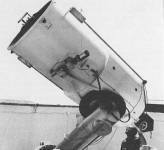 |
|
Prof.
Lyssimachos Mavridis and the 30inch Cassegrain telescope in
1971
|
The Stephanion
Observatory's legacy
The contribution of the Stephanion Observatory to Hellenic astronomy
as well as the international scientific world has been significant.
It is also needless to say that the region benefited a great deal
from the installation of the observatory at Stephani. Back in the
1960s the observatory contributed largely to the development of
the infrastructure: The old gravel road leading from the town of
Chiliomodi to Stephani passing through the villages of Klenia and
Aghionori was surfaced with asphalt, facilitating access not only
for the scientists but for the local population as well. In a time
when much of the rural population in Greece still lived without
electricity and telecommunications, power and telephone were distributed
to Stephani -and consequently at the other villages as well- due
to the installation of the observatory. Furthermore especially during
the operation of the French satellite tracking station, the observatory
employed many Stephanians as cooks, drivers, guards, gardeners and
chambermaids.
The situation of multiculturalism
created by the activities of the observatory in the early years
of its operation was handled quite successfully. The diversity of
cultural and educational background has represented no insurmountable
boundary for the communication between the villagers and the scientists
and has exerted a rather stimulating influence on the village, enlivening
and enriching everyday life. Relations between astronomers and villagers
have resulted in friendships that last until today and even in one
marriage. Countless stories surrounding the observatory exist that
could easily fill volumes.
The Stephanion Observatory
and its research activity has enhanced and shaped the identity of
our village, creating an interesting and attractive blend of cultural
heritage and technology. After 40 years of operation the Observatory
is irrevocably connected to the past, present and future of Stephani
and represents an important asset of the cultural and scientific
heritage of the greater region. The continuation of research activity
at the Stephanion Observatory is of scientific and cultural importance
with much to offer to future generations.
(The Stephanion Observatory,
L.N. Mavridis, University of Thessaloniki)
|


